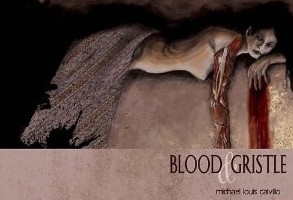 By MICHAEL LOUIS CALVILLO (Bad Moon Books; 2010)
By MICHAEL LOUIS CALVILLO (Bad Moon Books; 2010)
Having read Michael Louis Calvillo’s two previous books, the novels I WILL RISE and AS FATE WOULD HAVE IT, I know to expect the unexpected from this defiantly individual talent. BLOOD & GRISTLE is Calvillo’s first collection, showcasing 20 short pieces distinguished by Calvillo’s tightly controlled, sensory-inflected prose and brilliantly disturbed imagination. I already knew those attributes worked well in novel form, but it turns out they make for equally vital short stories.
“Head Two” is the starter, a cockeyed look at a day in the life of people with detachable body parts. Be advised that if you flinch here you probably won’t make it through the rest of BLOOD & GRISTLE, as it only grows steadily weirder.
“The Box” is a deeply bizarre piece about a mysterious box that turns up on a suburban family’s front porch. Where this story goes I’ll leave for you to discover, but will reveal that it ultimately reads like some kind of nutty collaboration between John Hughes and H.R. Giger. As for “The Current,” about a young woman and her abusive mother, it begins one way then morphs into something else entirely (i.e. something far more disturbing) and ends up in yet another arena altogether (i.e. one far more meaningful).
“Evolutionary Principles” is one of the book’s standout pieces, an account of a suicide and the emotional chain reaction it inspires in a witness and her acquaintances. “Gell-Us-See” may be an evocation of schizophrenic insanity brought on by extreme jealousy or a freaky account of surreal transformation. “Armor” is even stranger, a free-form reverie concerning poverty, disillusionment and tooth decay.
“Consumed” is representative of the book’s considerable range, and the closest of these stories to the slip-streamy prose of I WILL RISE. It’s a vivid depiction of a man trying to worm his way out of a pile of dead bodies that comes to impart some very real queries about life, death and everything in between. “Spirals (Undead Design)” is nearly a companion piece, being a similarly introspective evocation of unearthly disquietude.
I don’t quite agree with the title of “The Girl with No Hands,” as it gives away the ending, but I can’t fault the story, a wholly unique account of an injured man who makes an infernal deal in an effort to lessen his pain. “Zoo Etiquette” I’m unsure what to make of; it’s something of a cautionary tale about why it’s not a good idea to provoke lions in a zoo, told for some reason in reverse chronological order and encompassing three different viewpoints.
“Walls of Glass” examines what life might be like for a test tube baby, with severe delusions of grandeur being that individual’s main affliction. The longish “Placebo Effect” is a mind-blower about a college professor looking to balance his two loves: a young woman and crack cocaine. He eventually figures out how to do so in a conclusion that must be read to be disbelieved.
“The Shape of Things to Come” is actually the opening of an as yet unpublished novel called BASILISK, but works fine on its own. It’s about a kid who conjures a telepathic dragon through ancient Eastern magic—unwisely, as it turns out!
The final piece is nonfiction, revealing why Mr. Calvillo writes what he does. The explanation, as revealed here, has to do with his feelings about death, and the possibility that, contrary to what his Catholic upbringing promised, there may be nothing waiting for us on the other side. A scary thought, especially (I imagine) for one who was raised Catholic.
While I didn’t understand everything about these stories, there isn’t a single clunker in the bunch. All the pieces follow their own inscrutable logic to its inevitable (and often quite unpleasant) conclusions. There are no false happy endings here (for that matter, there really aren’t ANY happy endings period), nor any concessions to commercial sensibilities. Indeed, many of BLOOD & GRISTLE’S stories are SO weird they’re beyond the scope of traditional criticism—and in my view that’s to their credit.
